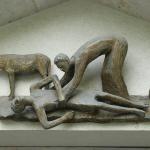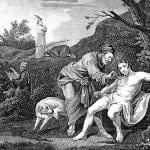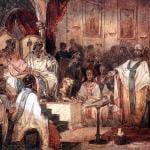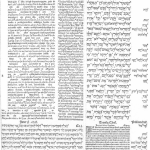Rome, Italy, Mar 27, 2017 / 12:02 am (CNA/EWTN News).- A veteran Vatican official praised EWTN foundress Mother Angelica as a pioneer of the New Evangelization, saying the way in which the Church speaks to the men and women of today wouldn't be the same without her influence. “I think Mother Angelica was a New Evangelizer ante litterum (before her time),” Monsignor Graham Bell told CNA. An official of the Pontifical Council for the Promotion of the New Evangelization who has spent around three decades in Rome, Msgr. Bell said that while St. John Paul II coined the phrase some 30 years ago, Mother Angelica had been an active player “long before.” “She just fits into that so well, because why do we have the New Evangelization? Not because the Gospel is new – the Gospel is ever-new, but it’s also unchanging, and the 'new' in the New Evangelization is essentially seeking to find new languages with which to communicate the Gospel to the men and women of our time.” Mother Mary Angelica of the Annunciation founded EWTN in 1981, and it has since become the largest religious media network in the world. She died March 27, 2016 after a lengthy struggle with the aftereffects of a stroke. She was 92 years-old. Mother Angelica, Msgr. Bell said, was able to talk about even difficult or sensitive topics in a meaningful way that always brought people “back to the center, which is Christ.”Please see below CNA's full interview with Msgr. Bell:One of the reasons I wanted to speak to you about this is because of the frequent remarks you’ve made in the past about Mother Angelica and what she accomplished. Why is she such a striking and important person for you? I came to Mother Angelica not through her television programs, but maybe at the beginning of the 2000s, there was a craze – maybe it was more popular then, I’m not sure, but there was a kind of podcast craze, and what EWTN did at that time is they would put out Mother Angelica live as a podcast, so I faithfully downloaded this every week. I didn’t know this nun before I started listening to the podcasts, and what immediately became clear is that there’s nothing original in Mother Angelica, she’s not trying to be original, all she’s trying to do is she’s taking the Word of God, she’s taking the teaching of the Church and she’s applying them to people’s lives. And the more I listened to this lady, the more I was reminded of Cardinal Newman’s motto: Cor ad cor loquitur, heart speaks to heart. And she has this phenomenal capability of speaking to your heart, and that comes across. Obviously I was listening to it as a podcast, I couldn’t see how people were reacting in the studio to what she was doing, but this great humanity came out. I think Newman got his motto from Saint Francis de Sales, and I think Francis de Sales said heart speaks to heart, whereas the tongue just hits the ear. You always had the impression with Mother Angelica that her heart was behind what she was saying. It struck people as true because she recognized it as true, and I think this is a phenomenal gift. It’s a gift every preacher should seek to have, but it’s also a gift that every Christian should seek to have. This phenomenal capacity to communicate and to communicate the unchanging truth of the Gospel in a way that’s relevant for men and women today, and that’s an art, it’s a grace.Do you think this is a reason she’s been so attractive and appealing to so many people? Yes, I do. Because language changes, and it changes now at a greater pace than it’s ever changed, and Mother Angelica in my opinion was able to bridge the gap. Sometimes the institutional Church isn’t good at speaking to people, but I think Mother Angelica, first of all with her many books, and then when she got the television and radio thing going, she was capable of bridging that gap. I can think of many things she said about people with addictions, you know? Sometimes the Church isn’t good at doing that, but she was good at looking at things which were difficult to talk about, but talking about them in a way that was very, very meaningful and always bringing people back to the center, which is Christ. I listened to all of her podcasts, and I just thought it was phenomenal. It certainly helped me in my preaching, and also helped me in the living of my priesthood.In view from your position on the Council for the Promotion of the New Evangelization, how do you think Mother Angelica has influenced the New Evangelization? Clearly she’s been a huge personality … I think Mother Angelica was a New Evangelizer ante litterum (before her time). I think John Paul II coined the expression himself in 1979 when he was in Poland, and what Mother Angelica had been doing long before that was certainly New Evangelization, certainly. She just fits into that so well, because why do we have the New Evangelization? Not because the Gospel is new, the Gospel is ever-new, but it’s also unchanging, and the “new” in the New Evangelization is essentially seeking to find new languages – I use the term language in the extended sense – with which to communicate the Gospel to the men and women of our time, who obviously have to hear the Gospel in a language which can understand. But the thing about Mother Angelica is, it was never the case of communicating a content which really didn’t concern her. Her communicating the Gospel was she was really communicating a part of herself, because Christ was so much a part of her and a part of her religious vocation. In communicating Christ through television, through radio, through her many books, she was actually communicating a part of herself, she was so identified with Christ, and I think that’s the heart of the New Evangelization. Obviously another thing I think is very close to the heart of the New Evangelization is the whole question of witness. Because how did Jesus communicate the Gospel to his disciples? He is the Gospel in himself and in his person. It was done through what he said and what he did, and what he said and what did find their center in his very person. So it must be for those who witness to the Gospel. It’s not enough just to speak about Christ, and it’s not enough just to do good works. There has to be a relationship so that what we say is explained by what we do, and what we do is explained by what we say. And I think in Mother Angelica, as in the great saints, this is exemplified, this is exemplified very, very strongly.A lot of people see the impact she had specifically in the Church in the Unites States and say that she changed the Church in the U.S. during a really critical time, but we also see that this is spreading very internationally. With your experience and in your time following EWTN, how do you see that she’s influenced culture even here in Europe? Mother Angelica, it must never be forgotten, was a woman religious. And women religious have a very, very, very important role to play in the New Evangelization and in the Church generally, because people react so favorably to them, because they express the maternity of the Church in a way in which priests and men religious really aren’t capable of doing. Mother Angelica, I think, is exemplary in this, and in her clarity of identity. What you see is what you got, there was no mystification there. You saw this nun with her habit, and she was always the same, the message was always the same, and this sense of authenticity I think absolutely captivates people. And I think that’s a big part of her secret and why she’s so popular. It’s this capacity of expressing maternity in an age in which maternity is not very fashionable.Being here in the Vatican for so long – you’ve been here for about 30 years, right? – have you seen any impact that she’s made here specifically? I don’t know about that, about what impact she’s made here. I think she’s made a positive impact to the extent that I think women religious always make a positive impact. When women religious are faithful to their vocations and faithful to the Church, they always make an impact, and I think the history of the Church demonstrates this. I wouldn’t be able to say what her impact has been on the various dicasteries. Certainly I do consider her one of the forerunners of the New Evangelization, and it would be difficult to imagine the New Evangelization without figures like her. I think one of the keys to the success of the New Evangelization will be how we can involve women religious in this project. I think the more we involve them, the more the New Evangelization will be successful.So in your opinion, aside from EWTN, what do you think is the core of the legacy she has left that and that we’re continuing to see grow? I would say this very, very humble, that I think today in the Church we are very much concerned, I would even say obsessed, by the question of communications, because we want to keep up with the times and we realize that this is very, very important; communications are a very important part of how the modern world works, and it’s important that the Church should be there. But what we must never forget, in my opinion, is that content always has a primacy over the technical aspect. The technical aspect is absolutely wonderful, but if you’ve got nothing to communicate it's completely useless, and I think Mother Angelica, she wasn’t just the person who founded this fantastic, hotshot television network that was financed completely by the people who listened to it. It wasn’t just that. It was the fact that she always put content first, and I think that’s a great part of her legacy. But I also think another equally important part of her legacy is the eternal truth of our Catholic faith. It always has been and always will be until Christ comes again, it’s a question of a man or a woman who believes in the Resurrection of Christ, looks into the eyes of another man or another woman and says ‘I believe’, and asks you to believe, too. And Mother Angelica exemplifies this; the transmission of the revelation, the transmission of our faith will always be an interpersonal relationship, and all of the hardware and all of the software and all of the gadgetry will never be able to replace that. And she never imagined that EWTN or her various initiatives would ever substitute this interpersonal transmission of the faith. So I think her legacy will be discovered 10, 20 years down the way. I really do.Would you say that part of the appeal and effectiveness of how she communicated the Gospel and the Resurrection had to do with how she experienced it in her own life? Yeah. She suffered. I can’t remember all the details of her biography, but I know early on in her life she had a serious medical conditions, and these were overcome and they were overcome through prayer. She might also have been the subject of a miracle, thinking about her very early life before she decided to become a nun. And then all through her life she battled through ill health. One of the things that makes her so authentic is that when you listen to – one of the things I used to love about EWTN was listening to all the podcasts, and you could hear her coughing, and she would put a cough sweet into her mouth, and if you look at the big, sleek media operations like the BBC, you very rarely hear people coughing and at EWTN you could hear all this, and it was so human. With technology, I think a television lens transforms everything, and it really is – if it’s the great observer, it’s also the great betrayer because you look at these television studios and how they come through the lens of the camera, but when you actually go there and you see how they’re built with all the cables everywhere that people never see, and the lighting makes it seem much bigger than it is, it’s smoke and mirrors, it really is from start to finish. You never got that impression with EWTN. You got the impression that here’s a lady in her parlor, speaking to you in your parlor, that’s what it came across as. So she coughed, and she put in a cough sweet and it was wonderful.Did you ever get to meet her personally? I didn’t, no. I always used to ask – sometimes we got people coming up from EWTN – I would always ask how is she, and I think the most of the latter half of her life she was bedridden. And sometimes you wonder what did God want from her in that time? What was her vocation in that time? That’s very difficult to discern.It was striking to me that the culmination of those last few years and then to pass away on Easter after what I understand were very excruciating last days. There was clearly something at work … Her oneness with Christ … Another chap who greatly influenced me when I was listening to Mother Angelica about 10-12 years ago was Father Benedict Groeschel, because he had Sunday Night Live. That would come out as a podcast and I would download that too. He is another one, I think they’ll both be saints. With Benedict, I know something happened at the end of his life, but that will be forgotten. In fact, it should probably be forgotten right away, because I don’t think he said what he was intending; an old man – and a young man – can make mistakes. But I am convinced that both of them will be beatified, I’m absolutely convinced. Read more
















